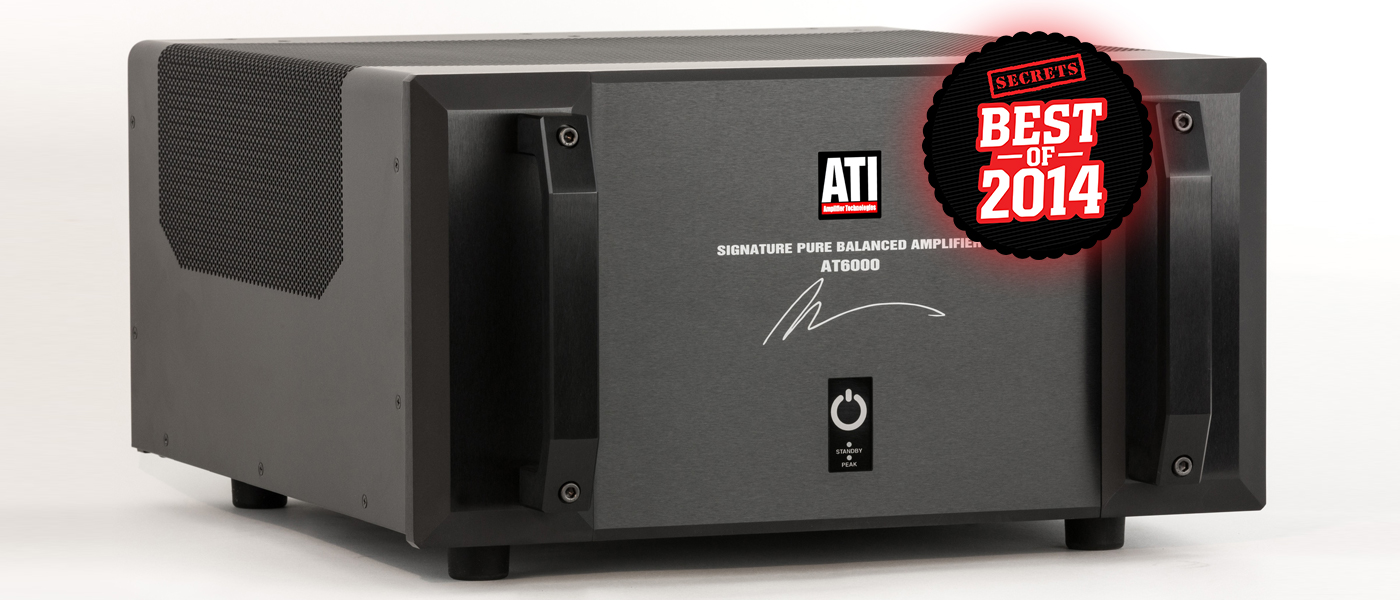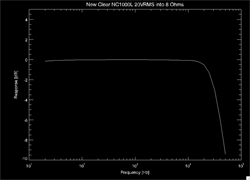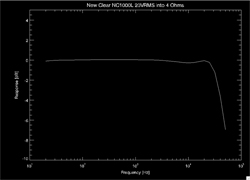Introduction to the NewClear Audio NC1000L Amplifier
Class D (i.e., “Switching”) amplifiers have been around for quite a while now. What’s clear from models produced so far is they all sound different, even when using the same core technology. Like many amplifiers of the type, the NewClear NC1000L uses the Bang and Olufsen ICEPower module. What makes the NC1000L different isn’t this module; it’s how that module is implemented. NewClear Audio was started by Sean Brady to improve upon the sound of existing switching amplifiers. Sean had heard some very good amps based on ICEPower technology, but thought he could do even better. The question is, does the NC1000L deliver the goods compared to similarly priced, traditional Class A/B amplifiers? We will see.
NewClear AUDIO NC1000L AMPLIFIER SPECIFICATIONS
- Design: Class D (“Switching”) Stereo Power Amplifier
- Power Output: 500 Watts/channel into 8 Ohms; 1,000 Watts/channel into 4 Ohms
- Peak Output Current: 40 Amps
- Dynamic Range: 120 dBa
- Frequency Response: 5 Hz to 45 kHz, -3 dB at 8 Ohms
- THD+N: < 0.1%
- IM: < 0.002%
- Dimensions: 4.25″ H x 14.25″ W x 16″ D
- Weight: 26 Pounds
- MSRP: $2,950 USD, Purchase On-Line Direct from Manufacturer
- NewClear Audio
- SECRETS Tags: NewClear Audio, Stereo, Power Amplifiers, Class D
The Design of the NewClear Audio NC1000L Amplifier
The NC1000L is based on the Bang and Olufsen ICEpower 1000ASP module. This mono class D amplifier module can deliver 500W into an 8 ohm load and 1,000W into a 4 ohm load. It’s happy even driving a 2 ohm load.
Some manufacturers simply put two of these modules into a box. Unfortunately, this isn’t the best idea. While the ICEPower1000ASP module has some very impressive output specifications, including a 5 milli-ohm output impedance, 120 dB dynamic range, and very low THD all with almost no heat production, it does have some drawbacks. The main issue with the module is the input impedance. This value should typically be very high, allowing an easy match to a preamp. The ICEPower1000ASP’s input impedance is only 8 kOhms, a relatively low value. If paired with a low output impedance preamp, there won’t be any issue, but with some tube preamps, or especially a passive preamp, there will be big problems. Some manufacturers deal with this by including an op-amp based input stage. This needs to be done very well, and certainly has the potential to make the sound of the amp significantly worse. With the NC1000L, NewClear takes a completely different approach.
The input stage of the amp is a Lundhal LL7902 input transformer. Lundhal makes some of the best transformers in the world, and the LL7902 is their top of the line transformer for the input stage. The transformer’s bandwidth is 5 Hz to 45 kHz, fully encompassing the relevant audio frequencies, while rejecting both DC and high frequency noise. The transformer is wired in a 2:1 stepdown configuration, which multiplies the downstream impedance by four. The result is a completely passive input stage with an input impedance of 32 kOhms. This still isn’t a super high number (something like 100 kOhms would be better), but it’s certainly way better than 8 kOhms.
The downside to this plan is the 2:1 stepdown costs 6 dB of gain. The ICEPower1000ASP module has 28 dB of gain on its own, so implementing the LL7902 in the NC1000L results in 22 dB. This is a relatively low gain for a power amp, and needs to be taken into account when matching to a preamp. A 32 kOhms input impedance is still too low for a passive preamp, plus a passive preamp’s lack of gain may result in too low an output level with low sensitivity loudspeakers. The same goes for an active “buffer” preamp like the PassDIY B1 Buffer. This type of preamp also has no gain. With any standard active preamp with reasonable output impedance, you’ll have no issues with the NC1000L.
The NC1000L was clearly designed to deliver performance first and cosmetics second. While the amp is certainly handsome, it does not have the bespoke, jewelry like cases that some very expensive amplifiers sport. The amp uses a commercially available case with a machined aluminum faceplate, which saves a huge amount of money over a fully custom enclosure. The amplifier is equipped with high quality shielded binding posts on the rear panel, which accept spades, bare wire, or banana plugs. The size of the spades is limited by the binding post shields. My Wireworld Eclipse cable spades barely fit, but made it.
Inside the case, the NC1000L has a pair of ICEPower1000ASP modules and the Lundhal input transformer. The 1000ASP module comes with a built in power supply, so there’s no need for any separate outboard supply to provide the DC voltages needed by the 1000ASP. A single 1000ASP can power another 1000A without a power supply, but NewClear uses 1000ASPs for both channels, so each has its own dedicated power. Internal wiring is all DH Labs silver-plated copper wire with Teflon insulation. Some components are cryogenically treated for improved electrical conductivity. Both RCA and XLR inputs are provided. Since the ICEPower modules are fully balanced internally, they can take full advantage of the XLR inputs.
The NewClear Audio NC1000L Amplifier In Use
My reference amps are Emotiva XPA-1 500W monoblocks, which I bought after a review a few years ago. These amps have exceptional power, control, and clarity for a very low price (about $2,000/pair). The most immediate improvement was in the bass output. After listening to your own system for a while, you come to realize what the drawbacks of the system are, but sometimes it isn’t clear what is holding the performance back. Sometimes, you don’t realize there was a problem until you hear the solution.
In my case, I thought the bass extension and impact of my system (Gallo Reference 3.5s, with the Reference SA amplifier driving the second voice coil of the woofers) was really good. When I put the NewClear into the chain, replacing the huge XPA-1s, I thought I had replaced the speakers, or at least messed with the settings on the Reference SA. The improvement in impact, solidity and extension were significant. Given I was replacing 500WPC amps with another 500WPC amp, I did not expect this. Another thing I didn’t expect was how this would manage to improve everything from bass-heavy electronica to acoustic jazz. Certainly, albums like Daft Punk’s Human After All socked me in the stomach as expected, just harder and with more impact.
Jazz albums, particularly those featuring acoustic bass, were able to give a bit more reality to a very hard instrument to reproduce. Typically, acoustic bass reproduced through a stereo system always sounds small and thin compared to the real thing. While still not “live”, the NC1000L brought my system just a bit closer to putting the size and weight of a real bass in my room. I found myself listening to all my Charles Mingus and Modern Jazz Quartet albums. Percy Heath’s bass on The Complete Last Concert (always exceptionally well recorded, since Heath demanded it), sounded big and solid, with plenty of wood sound. Another thing listening to Heath’s bass revealed was the detail, speed, and clarity that the NewClear amp could deliver.
Bass has a lot of subtle sounds: fingers on the strings, strings slapping against the fingerboard, the reverberation of the wood. It’s not the easiest thing to extract all these sounds from an album. Once again the NC1000L showed me I had something missing in my system I didn’t know was gone.
I’ve said similar things about the XPA-1, but the NC1000L took the system another step forward, most noticeablly in the bass. The Emotiva, while still excellent, was just a little less in this kind of sound output. Whether it was lower distortion, lower noise, or something else, the NewClear was most definitely clearer, quieter, and more precise than the already very good XPA-1. All this is delivered by a small, light amp with super high efficiency. No heat, no high electricity bills, no hernias.
Class D amps are small, light, and run cool. Class A/B and Class A amps are big and heavy with huge heat sinks. They look and feel like they’re expensive. I assure you that while the NC1000L may not feel as expensive as a pair of big Class A/B monoblocks, it certainly sounds expensive.
The NewClear Audio NC1000L Amplifier On The Bench
The NC1000L is a balanced amplifier with balanced outputs. This means you cannot connect the negative amp terminal to chassis ground since it goes negative in voltage while the positive terminal goes positive in voltage. Unlike some balanced amps (like the XPA-1), there is no protection for a short to chassis ground, only to the terminals being shorted to each other. Shorting an amp terminal to chassis ground will destroy the ICEPower module. I was not confident my normal test equipment (a M-Audio Profire 610 Firewire audio interface and Spectra Plus analysis software) had floating grounds.
I arranged with Sean Brady to visit a local tech who has access to an Audio Precision system who could make some measurements for me. His AP system was only configured to make a limited number of measurements, so I was not able to include the normal distortion spectrum and IMD measurements I normally do. I was able to make frequency response and THD+N measurements.
Frequency response measurements were made at 20VRMS into both 8 Ohms and 4 Ohms, corresponding to power levels of 50W and 100W. Both measurements are exceptionally flat, but the 4 Ohm measurement does show a small dip (0.2 dB) at 10 kHz. Response rolls off above ~40 kHz due to the bandwidth of the input transformer. This is one of the advantages of the transformer, preventing out of band noise from getting through.
THD+N levels are very low, particularly at low frequencies where the numbers are 0.01% or less. Starting at about 1 kHz, the THD+N level begins to rise linearly, but still remains good. The tech was having some problems with high frequency noise getting into his measurement system, so these numbers should be seen as upper limits at high frequencies. The amp is likely better than this measurement shows.
Bench Tests by J.E. Johnson, Jr.
Below are some bench tests that I wanted to add to this review, since they are standard for our tests of power amplifiers. I was not able to test the maximum power output due to blowing fuses when the output began to reach the maximum. This is because Class D power amplifiers typically only have a fraction of the power supply capacitance that Class A/B power amplifiers have. Supposedly, this is because Class D is so much more efficient (>90%) than a Class A/B amplifier (~50%). It surprises me that this is the case, because no matter how efficient the power supply is, it still has to deliver the full output, and for 1,000 watts, it still would require a lot of power supply capacitors, because that is where the current comes from to be sent to the output stage. In my opinion, the 1,000 watt/channel rating is a peak output rating rather than RMS, because it does not meet the specification for RMS output (continuous output). My guess is that it will produce about 700 watts/channel on a continuous basis, and 1,000 watts/channel for very short periods.
Anyway, here are my test results. All tests were within an 80 kHz bandwidth, and output was into an 8 ohm load, both channels driven.
At 1 kHz and 5 volts output, THD+N was 0.02%. This is pretty typical of Class D performance. The third harmonic predominates.
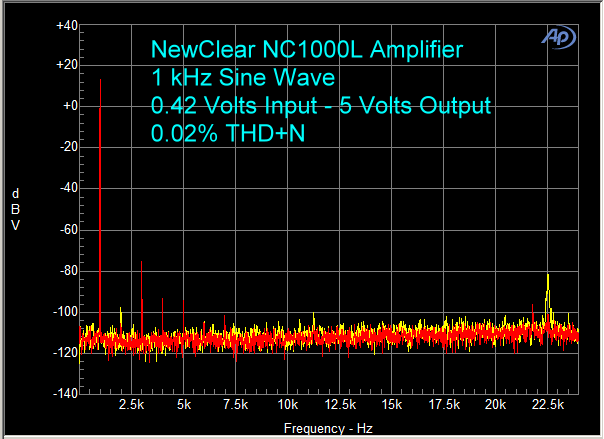
At 20 volts output (50 watts at 8 ohms), distortion rose to 0.07%. There are a lot of harmonics, and the noise floor is about 10 dB higher. Many of the harmonics reach the – 80 dB range, so they are audible. However, the sound is not necessarily bad. In this case, the combination of the harmonics was pleasant, according to the subjective listening experience of the reviewer (Dr. Groppi).
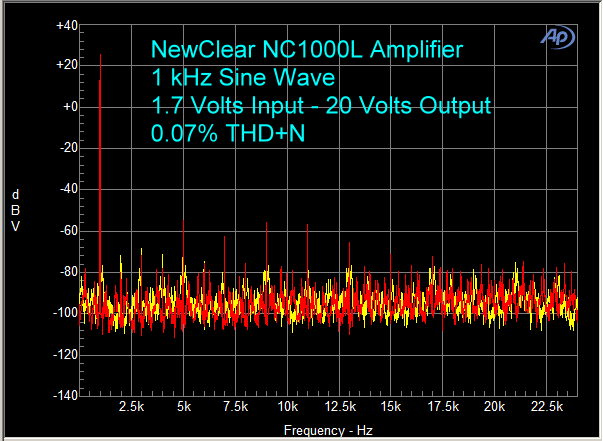
The 19 kHz, 20 kHz test resulted in only 2 or 3 side peaks (2-3 on each side) next to the test signal peaks. The B-A peak at 1 kHz was buried in the noise floor, which appears to be about – 95 dB.
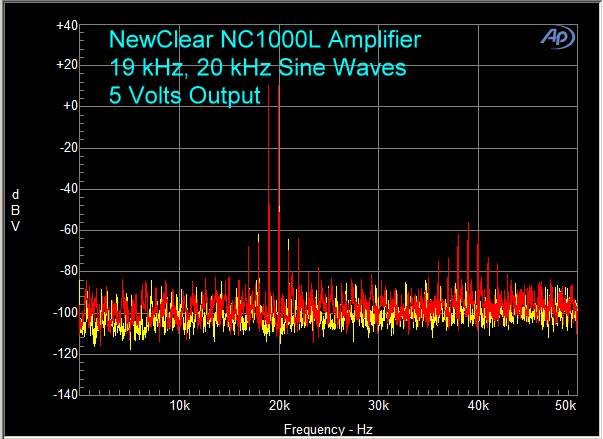
At 20 volts output, there were many side peaks, and quite a bit of activity all the way out to 50 kHz. Again though, this does not necessarily detract from the sound. It’s all a matter of what kind of sound characteristics you like.
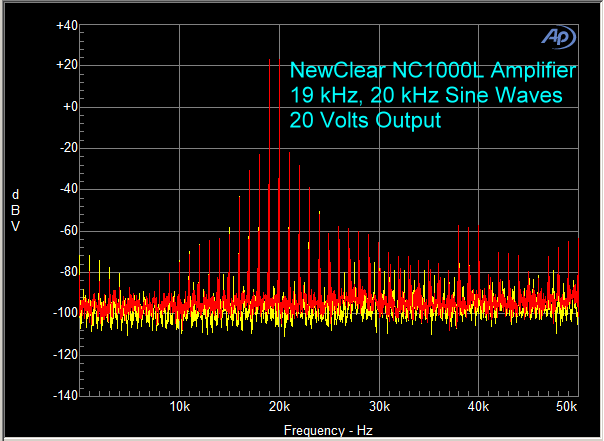
IMD was 1.3% at 5 volts into 8 ohms. Under most circumstances, this would be considered clipping (1% THD+N and above), but the noise floor is so high (- 90 dB), this makes the measurement higher than it actually is in terms of IMD by itself. You can see that there are no side peaks next to the 7 kHz test signal (high IMD would present itself as a little pyramid at the base of the 7 kHz peak), and only a small peak at 14 kHz, which is the second harmonic.
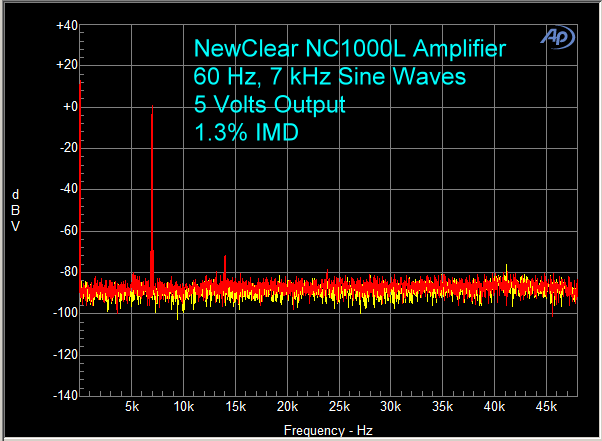
IMD at 20 volts resulted in a lower number than at 5 volts, but that is because the signal peak was much higher, but the noise floor remained the same. However, there are many more harmonic peaks to the 7 kHz signal peak, and the base of the 7 kHz signal peak has that little pyramid I mentioned above. That represents the IMD, which is an interaction of the 7 kHz signal peak with the 60 Hz signal peak (IMD is measured with 60 Hz and 7 kHz signals).
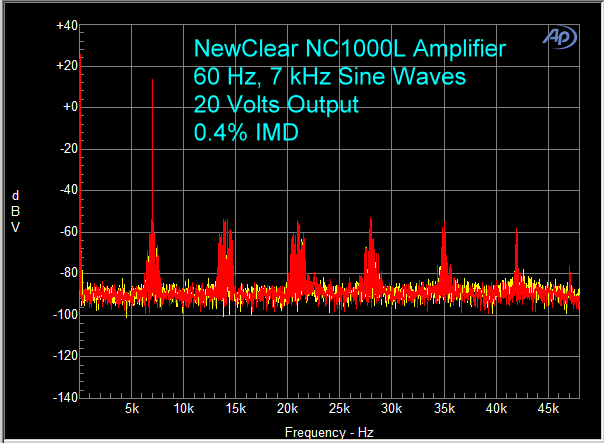
THD+N vs. Frequency showed that as the output rose, the hump between 2 kHz and 40 kHz got larger. This produces a brighter high end of the audible spectrum, and can make detail more audible. However, there was clipping at 15 kHz with 20 volts output, but even just the second harmonic of 15 kHz would not be audible.
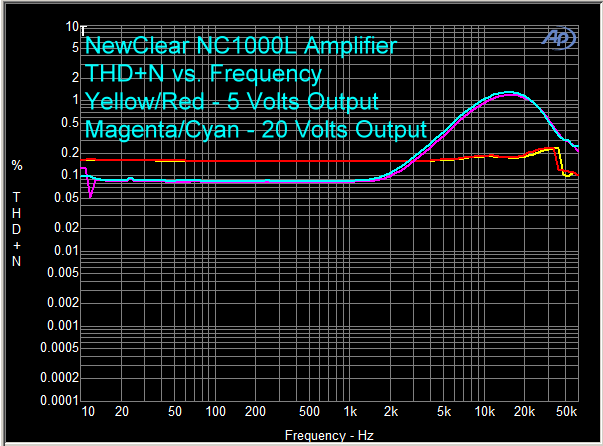
The measured Frequency Response was 10 Hz – 20 kHz, – 0.5 dB at both 5 volts and 20 volts output.
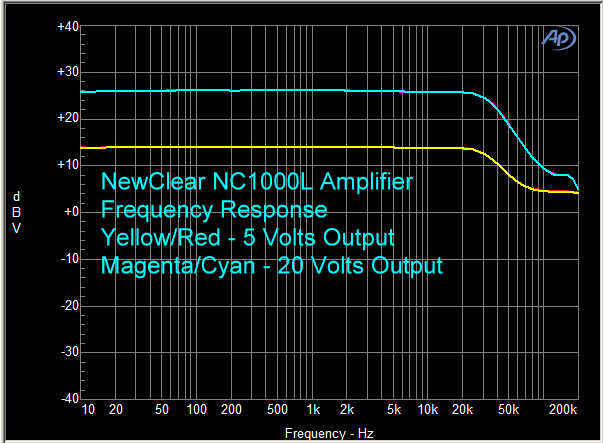
Conclusions about the NewClear Audio NC1000L Amplifier
When I reviewed the Emotiva XPA-1s, I said they’d be pried from my cold, dead fingers. I was a bit premature. At the time, I couldn’t imagine an amp that could better the XPA-1 for a similar price. The NC1000L has done it. It’s a bit more expensive than a pair of XPA-1s at $2,950, but the price is certainly in the same ballpark. And for that extra $950 you get an amp that, in my opinion, delivers better sound, while being much smaller, lighter, and cooler running.
Just like the XPA-1, the NewClear amp absolutely stomps most similarly priced competition. The amp sounds like it should cost at least double what it does, if not more. Sean Brady powers top of the line $22,000 Usher BE-20 speakers in his own home using a pair of NC1000Ls. As a dealer, he could really use anything, but he uses the NewClear.
If you can find a better amp than the NC1000L for anywhere near its $2,950 asking price, it may be time for you to upgrade if your current power amplifier(s) are not giving you what you want.


